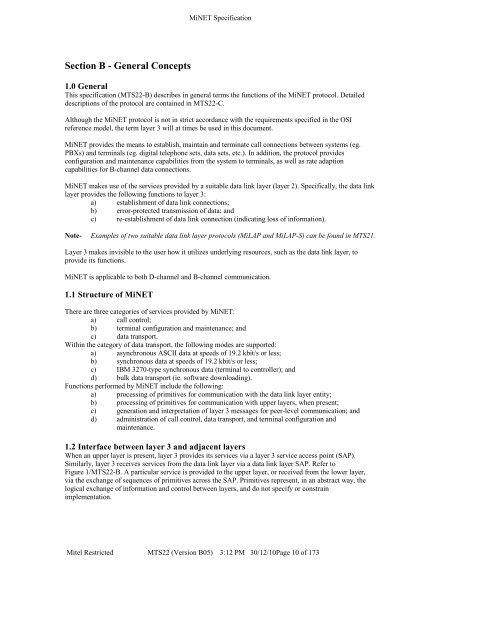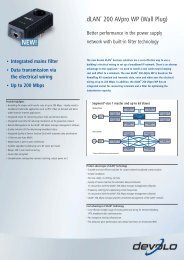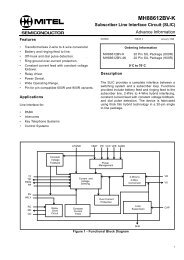Mitel Technical Specification 22
Mitel Technical Specification 22
Mitel Technical Specification 22
Create successful ePaper yourself
Turn your PDF publications into a flip-book with our unique Google optimized e-Paper software.
MiNET <strong>Specification</strong><br />
Section B - General Concepts<br />
1.0 General<br />
This specification (MTS<strong>22</strong>-B) describes in general terms the functions of the MiNET protocol. Detailed<br />
descriptions of the protocol are contained in MTS<strong>22</strong>-C.<br />
Although the MiNET protocol is not in strict accordance with the requirements specified in the OSI<br />
reference model, the term layer 3 will at times be used in this document.<br />
MiNET provides the means to establish, maintain and terminate call connections between systems (eg.<br />
PBXs) and terminals (eg. digital telephone sets, data sets, etc.). In addition, the protocol provides<br />
configuration and maintenance capabilities from the system to terminals, as well as rate adaption<br />
capabilities for B-channel data connections.<br />
MiNET makes use of the services provided by a suitable data link layer (layer 2). Specifically, the data link<br />
layer provides the following functions to layer 3:<br />
a) establishment of data link connections;<br />
b) error-protected transmission of data; and<br />
c) re-establishment of data link connection (indicating loss of information).<br />
Note-<br />
Examples of two suitable data link layer protocols (MiLAP and MiLAP-S) can be found in MTS21.<br />
Layer 3 makes invisible to the user how it utilizes underlying resources, such as the data link layer, to<br />
provide its functions.<br />
MiNET is applicable to both D-channel and B-channel communication.<br />
1.1 Structure of MiNET<br />
There are three categories of services provided by MiNET:<br />
a) call control;<br />
b) terminal configuration and maintenance; and<br />
c) data transport.<br />
Within the category of data transport, the following modes are supported:<br />
a) asynchronous ASCII data at speeds of 19.2 kbit/s or less;<br />
b) synchronous data at speeds of 19.2 kbit/s or less;<br />
c) IBM 3270-type synchronous data (terminal to controller); and<br />
d) bulk data transport (ie. software downloading).<br />
Functions performed by MiNET include the following:<br />
a) processing of primitives for communication with the data link layer entity;<br />
b) processing of primitives for communication with upper layers, when present;<br />
c) generation and interpretation of layer 3 messages for peer-level communication; and<br />
d) administration of call control, data transport, and terminal configuration and<br />
maintenance.<br />
1.2 Interface between layer 3 and adjacent layers<br />
When an upper layer is present, layer 3 provides its services via a layer 3 service access point (SAP).<br />
Similarly, layer 3 receives services from the data link layer via a data link layer SAP. Refer to<br />
Figure 1/MTS<strong>22</strong>-B. A particular service is provided to the upper layer, or received from the lower layer,<br />
via the exchange of sequences of primitives across the SAP. Primitives represent, in an abstract way, the<br />
logical exchange of information and control between layers, and do not specify or constrain<br />
implementation.<br />
<strong>Mitel</strong> Restricted MTS<strong>22</strong> (Version B05) 3:12 PM 30/12/10Page 10 of 173





